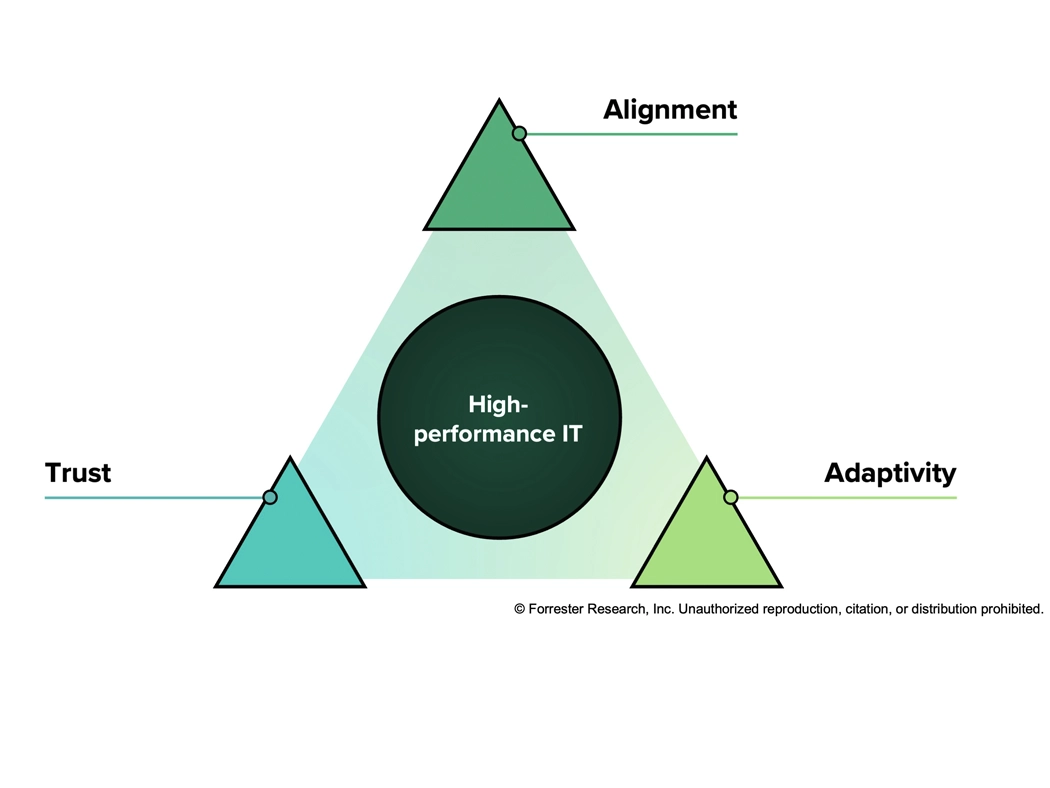Developing an effective enterprise technology strategy is not what it used to be. In the past, a small group of IT leaders would gather at budget time and focus on issues such as vendor contracts, system uptime, and spending limits. But in today’s enterprise, the process needs to be more strategic and align closely with the goals of the business overall, with specific functions helping drive continuous value. A successful technology strategy must start with a deep understanding of the enterprise business strategy and use this understanding to prioritize which outcomes technology is meant to deliver to business stakeholders and customers. A modern technology strategy must also be flexible enough to adapt to changing business requirements and build trust with business stakeholders. Forrester refers to the strategy of continuously improving business results through technology as high-performance IT.
This page outlines the best practices needed to develop a technology strategy that aligns with business goals and drives continuous results.
What Are The Elements Of A Successful Technology Strategy?
In today’s business environment, a successful technology strategy must do three things: 1) Continuously align with the business; 2) build trust on a foundation of security, privacy, and resilience; and 3) empower the business to readily adapt to changing market conditions and customer demand. Forrester’s high-performance IT strategy has been built on these three guiding principles of alignment, trust, and adaptivity.

Following are some details on the value of each principle and guidance on how to build them into your technology strategy.
- Alignment. Alignment ensures that technology delivers business outcomes. Businesses today operate in an environment characterized by constant change — be it market dynamics, regulatory shifts, or competitive pressures. If a technology strategy is not aligned with business goals, it risks becoming obsolete quickly, leading to misallocated resources and missed opportunities. Also, today’s digital business models rely heavily on technology integration to drive innovation, efficiency, and customer engagement.Emerging technologies such as AI, the internet of things (IoT), and blockchain are potent drivers of innovation, capable of unlocking novel business models and revenue streams. Without alignment, a technology strategy and its initiatives can fail to deliver the value expected or required by the business, resulting in suboptimal outcomes. By aligning IT efforts and business priorities, organizations ensure that critical projects receive the necessary attention and resources. They also improve their relationships with business partners — an important foundation for building trust.
- Adaptivity. Adaptivity speeds response to opportunity or threat. Technologies such as AI, machine learning, blockchain, and IoT are rapidly evolving, offering new opportunities but also presenting new challenges. An adaptive IT strategy allows organizations to exploit these technologies quickly and effectively. Whether due to economic shifts, global pandemics, or competitive disruptions, the business landscape can change unexpectedly.Adaptivity also helps IT pivot proactively to address these changes, minimizing downtime and maximizing resilience. Finally, an environment of adaptivity encourages ongoing learning and innovation within the IT organization. This continuous improvement mindset evolves the IT strategy in line with both technology trends and business needs, keeping the organization ahead of the curve.
- Trust. A successful technology strategy develops trust and confidence in IT’s role. When business leaders trust the IT organization’s strategy, it creates a collaborative environment where IT is seen as a strategic partner rather than just a service provider. This leads to better cooperation, quicker decision-making, and more effective execution of initiatives. Stakeholders are also more likely to support and back IT-led initiatives, even in situations requiring immediate responses or significant change. But trust takes work and commitment.Trust is built through consistent, reliable performance. An IT strategy that delivers predictable and repeatable results strengthens the credibility of the IT organization and builds confidence among stakeholders. Finally, transparent communication about IT strategy intentions, progress, and outcomes helps in managing expectations and reinforces the trust of the business leaders. This openness is key in building a trusting relationship.
How Do You Build Out A Technology Strategy?
With these guiding principles in place, the next step is to begin building out a more concrete plan, including a technology strategy on a page. Forrester recommends four steps that will help you develop a strategy that will align with the overall business priorities.
Step 1: Engage stakeholders to secure buy-in. To ensure that the technology strategy you develop is embraced and supported across the organization, you need to get stakeholders in at the ground floor. That means identifying stakeholders, gathering their expectations and concerns, and engaging key executives.
Step 2: Assess your IT organization’s current state. Developing a successful technology strategy requires a thorough understanding of the current business strategy and technological landscape. At this stage, you can conduct a SWOT analysis to evaluate your organization’s technological capabilities against industry benchmarks and identify gaps and areas for improvement in the new tech strategy.
Step 3: Run an immersive IT strategy workshop to drive alignment. With stakeholders identified, workshops foster the cocreation of the vision and objectives of the technology strategy. These collaborative efforts lead to a strategy that reflects a shared vision and collective insights.
Step 4: Finalize and communicate your strategy. By this point, you should be able to create a concise “technology strategy on a page” document to be shared across the IT team and broader organization. Maintain ongoing engagement and feedback to continuously refine and adapt the strategy, keeping it aligned with business objectives.
Examples Of Successful Technology Strategies
One of the biggest questions when developing a new IT strategy is: “What does excellence look like?” Finding organizations with strategies to benchmark against can be challenging. Each year, Forrester awards its Technology Strategy Impact Award to firms in the Americas, Asia Pacific, and EMEA that embody the three guiding principles of high-performance IT, which are alignment, adaptivity, and trust. Here are summaries of the 2024 winners of the Award.
- First Student This North American student transportation services provider’s IT organization has ensured that its technology strategy aligns with core business objectives by establishing an IT steering committee, conducting regular portfolio reviews, and fostering collaboration with business units. This approach has cultivated a culture of innovation, responsiveness, and continuous improvement within the organization. An example of this is the launch of FirstAlt, a bespoke digital solution serving students with unique transportation needs such as those with special needs or those experiencing homelessness. This initiative not only fills a critical customer need but also showcases the company’s innovative use of technology to enhance service delivery, exceeding revenue projections and achieving high customer satisfaction.
- Best Buy North American consumer electronics retailer Best Buy has developed a technology strategy that integrates cutting-edge technology into its operations. For example, the company uses AI-powered chatbots and self-service tools to enhance customer and employee experiences. The firm’s mobile-first strategy leverages data and AI to improve customer interactions and drive sales growth. Advanced analytics and intelligent automation further enable Best Buy to serve its customers more effectively, underpinning the company’s adaptivity and commitment to continuous learning. At the same time, Best Buy’s IT strategy is deeply rooted in ethical operations and trust-building, with a focus on leadership, governance, cybersecurity, privacy, resilience, ethics, and risk management.
- Macquarie’s Banking and Financial Services group (BFS) Macquarie BFS drives strong alignment between technology and the business by leveraging a control-tower approach and incorporating business objectives in the technology organization’s objectives and key results. Its agile software development platform helps it deliver business apps at high speed. Macquarie BFS also invests in the tools and practices that allow it to cocreate quickly and focus on amplification through its investments in AI and automation.
- Smart DCC (Data Communications Company) Smart DCC is at the forefront of the UK’s initiative to decarbonize its energy system, operating a smart metering network of more than 100 million devices, including 55 million smart meters. The technology function’s strategy and enterprise portfolio management team’s strategy work together to align technological initiatives with Smart DCC’s strategic objectives and the UK’s sustainability goals. Trust is key to Smart DCC’s strategy, so it has a strong focus on maintaining transparency with all government and industry partners.
- BNP Paribas Bank Polska After a series of mergers and acquisitions, the IT organization at BNP Paribas Bank Polska has shed its architectural and technological redundancies, positioning it as a trusted business partner. Its strategic annual planning process defines strategic objectives and results to ensure that its IT strategies are integrated with the business strategy. Its IT@Scale technology strategy has enabled the implementation of new technology solutions and concepts to increase efficiency and resiliency and power strategic growth. Despite heightened cybersecurity threats in Poland, the bank has maintained a robust cybersecurity stance, evidenced by one of the highest Bitsight scores in the market. Trust between IT and business domains is achieved through transparent communication, strategic collaboration within cross-functional groups, and a commitment to securing top IT talent and investing in their development.
Key Takeaways
In a continually changing business environment, tech execs must evolve, continually breaking away from old norms that limit their technology organizations from achieving high performance. The most successful technology teams will adopt an end-to-end shift toward emphasizing customer and business value, strategy-driven governance, shared accountability, clear communication, and smart spending. This fresh high-performance-IT approach allows businesses to thrive, seamlessly aligning technology strategy with the overall organization’s strategic business objectives, constantly driving business value through tech.
To achieve this alignment, it is crucial for technology leaders to have a deep understanding of the business strategy and ensure that the technology strategy be developed with a forward-thinking mindset, anticipating future needs and opportunities. By staying ahead of the curve and embracing new and emerging technologies, businesses can position themselves as industry leaders and gain a competitive edge.
Building trust is equally paramount in executing a successful technology strategy. Organizations should foster a collaborative environment where technology is seen as a strategic partner rather than a mere service provider. This trust is cultivated by consistently delivering reliable performance and maintaining transparent communication about the intentions, progress, and impact of the technology strategy. Engaging stakeholders throughout the process encourages a sense of ownership and promotes a shared vision of success.
A well-crafted technology strategy is essential for businesses aiming to thrive in today’s dynamic business landscape. By aligning the IT strategy with overall business goals, fostering trust and collaboration, embracing forward-thinking qualities and innovation, investing in research and development, and prioritizing cybersecurity, organizations can position themselves for success. With a proactive and strategic approach to technology, businesses can leverage transformative power to drive growth, enhance operational efficiency, and meet the evolving needs of customers.
Take Your Technology Strategy To The Next Level
Technology leaders today are under more pressure to develop a technology strategy that delivers business value and exponential growth. Your next step to developing a winning strategy is closer than you might think. Whether you have a strategy that needs an overhaul or you’re starting from scratch, Forrester can help.
Forrester Decisions for Technology Executives helps leaders develop a high-performance IT strategy that aligns to the business, creates trust, and adapts quickly. Forrester provides a bold technology vision for the future as well as the frameworks, blueprints, and guidance needed to build a forward-looking technology strategy.
Talk To Us
Find out how Forrester can help you develop a successful technology strategy that aligns to your business objectives and goals.
Thank you!
Ready to learn more now? Give us a call:
Americas: +1 615.395.3401
EMEA: +44 (0) 2073 237741
Asia Pacific: +65 6426 7060
